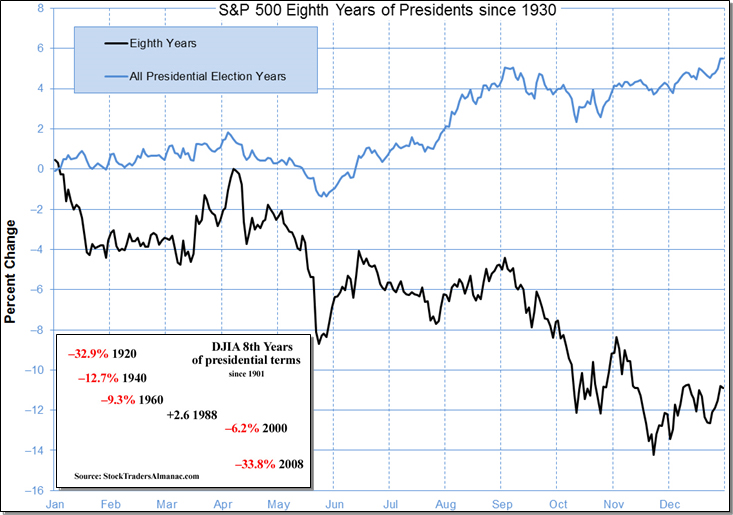The Russell 2000 entered bear market territory yesterday and the DJIA, S&P 500 and NASDAQ Composite all reached the 10% correction level. But today we have the first really good market day of the year. Most encouraging was that the morning rally held and tacked on more throughout the day, and only gave back a little on the close. Not the most convincing turnaround, but it’s a start, potentially creating a series of higher lows off the August and September lows last year.
This has been the worst start to a New Year on record, triggering bearish warning signs on several of our New Year seasonal indicators. There have been few places to hide, barely any respite and little solace. With our “Santa Claus Rally” (SCR) and “First Five Days Early Warning System” (FFD) in the red and the DJIA’s December closing low violated, a positive reading from our full-month January Barometer would go a long way in improving the prospects for the year.
If today’s oversold rally can hold and the S&P 500 can move up more than 8% by the close of the month our January Barometer will be positive and an indication that this current selloff is of similar ilk to the August-September correction last year. However, a negative January Barometer is not the death knell for the market. It sure suggests rough sledding and likely lower prices if history is any guide. A deeper examination of the historical record illustrates that despite the market’s current troubles – and even if the JB is negative – there will likely be a silver lining.
Of the past 10 times that the SCR and FFD were both negative, the December low was NOT violated only once in 1985 as you can see in the accompanying annotated table. 1985 is also one of the three years in the table that registered a positive January Barometer. All three were pure bull market years with solid gains. 1985 and 1991 were both up 26.3% and 1993 was up 7.1%.
The January Barometer was up in 2005 and the bull market raged on, but the year was flat with a paltry 3% gain. The other six years in the table are a mishmash, but only three are a total washout. 1969, 2000 and 2008 all registered losses for the next eleven months, the full year and beyond, delivering bear markets that spanned more than one year. The other three years, 1956, 1978 and 1982 all contained bear and bull markets and managed 11-month and full-year gains; modest in 1956 and 1978, but smashing in 1982 with the start of the last secular bull.
Whatever happens this January and this year, the beginning of the next secular bull and our
“Super Boom” forecast is getting closer on the horizon.
However, this does not mean that we get off scot-free this year. There is no doubt about it, the market is on shaky ground and the odds of further downside are increasing. On top of the China-slowdown fears, the oil meltdown and global violence and turmoil, President Obama’s rhetoric in his final State of the Union Address did little to quell investors’ concerns; in fact they may have fanned the flames. About the only positive, from a contrary perspective that is, is increased pessimistic sentiment and bearish market calls up and down Wall Street.
Way back in early June 2015, when I put the Stock Trader’s Almanac 2016 to bed and sent it off to the publisher, I warned that my outlook for 2016 was less than sanguine and that there was a low probability for substantial gains in 2016. Election years used to be the second best year of the four-year cycle, but the recent history of back-to-back-to-back two-term presidents (Obama, GW Bush & Clinton), plus several others in the 20th Century has impacted the 4th year of the cycle dramatically. Since 1941 the DJIA has been the worst of the 4-year election cycle.
While election years have been considerable weaker in recent history, eighth years of presidential terms represent the worst of election years since 1920. In eighth years DJIA and S&P 500 have suffered average declines of –13.9% and –10.9% respectively. Out of these six full years, only 1988 was positive. As a result, eighth years have vastly differed from the typical election-year pattern.
Prior to President Obama, there have been six previous presidents that served an eighth year in office since 1901; Presidents Wilson (1920), Roosevelt (1940), Eisenhower (1960), Reagan (1988), Clinton (2000) and G.W. Bush (2008). President McKinley was elected to a second term, but was assassinated in his fifth year in office. Nixon was also elected to a second term, but resigned in the face of the Watergate scandal in his sixth year in office. Eighth years are also presidential election years. In the following chart the one-year seasonal pattern for eighth years is compared to all presidential election years.

Making matters even worse, 2015 registered the first losing pre-election for DJIA since war-torn 1939 when Germany invaded Poland (S&P 500 was down 0.7% in 2015). This is not a great sign. 1939 was the seventh year of FDR’s Presidency, his second pre-election just as 2015 was for Obama. The S&P 500 was down 5% in 1939 and as WWII broke out in Europe the stock market was down double digits the next two years.
With seasonals, cycles, fundamentals and technical all flashing warning signs, caution is clearly in order. At a bare minimum consider sitting on the sidelines for the time being and holding some cash. Once we have our full month January Barometer reading and more economic, technical and fundamental data points at month’s end, we’ll adjust our forecast and outlook for 2016 if need be. So for now, don’t expect big gains this year and sit tight.